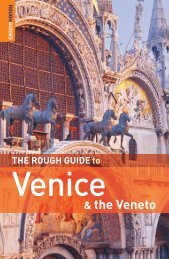You also want an ePaper? Increase the reach of your titles
YUMPU automatically turns print PDFs into web optimized ePapers that Google loves.
14 CuLture & events<br />
The Feast <strong>of</strong> St Blaise<br />
Phil Newman<br />
03.02 2012 Friday<br />
Falling on February 3, <strong>the</strong> Feast <strong>of</strong> St Blaise (Sveti Vlaho, see<br />
p.XY) is arguably <strong>the</strong> most important date in <strong>the</strong> Dubrovnik<br />
calendar, bringing hordes <strong>of</strong> local people onto <strong>the</strong> streets<br />
and showcasing a good deal <strong>of</strong> folkloric tradition.<br />
In September 2009 <strong>the</strong> feast was included by UNESCO<br />
on <strong>the</strong> so-called “Intangible Cultural Heritage” list, which<br />
aims to nurture unique social rituals which have a long and<br />
au<strong>the</strong>ntic history. The cult <strong>of</strong> St Blaise has been central<br />
to Dubrovnik since <strong>the</strong> tenth century, and his feast day is<br />
known to have been celebrated every year without a break<br />
since at least 1190.<br />
The festivities commence on February 2, when doves are<br />
released in front <strong>of</strong> St Blaise’s Church by <strong>the</strong> Bi<strong>shop</strong> <strong>of</strong><br />
Dubrovnik. The next morning a commemorative mass is<br />
held, followed at around 11:30 by a solemn procession <strong>of</strong><br />
priests and locals, many wearing folk costume and waving<br />
Easter time<br />
If you happen to be in town at Easter, you’ll have <strong>the</strong> good<br />
fortune to be able to sample <strong>the</strong> local foods <strong>of</strong> <strong>the</strong> season<br />
and experience how Easter traditions are interpreted in<br />
and around Dubrovnik. Easter eggs here are handmade<br />
by chickens, and decorated by people with delicate motifs<br />
in beeswax, coloured with onion skin or pine (a process<br />
locally known as penganje). The result was an ornament<br />
to be given as a mark <strong>of</strong> love, friendship and devotion. On<br />
Palm Sunday people carry olive branches or intricately<br />
woven ornaments made from palms leaves. You can learn<br />
how to make <strong>the</strong>se decorations yourself at <strong>the</strong> Easter<br />
work<strong>shop</strong>s run by <strong>the</strong> Deša humanitarian women’s group.<br />
(See: Interactive Category)<br />
The Sponza Palace (Palača Sponza) D-3, Svetog<br />
Dominika 1. For many, <strong>the</strong> most romantic <strong>of</strong> Dubrovnik’s<br />
buildings, with its gallery on Stradun and its mix <strong>of</strong> gothic<br />
and renaissance detail, this was always a public building.<br />
Directly facing Orlando’s column, <strong>the</strong> scene <strong>of</strong> all dramas <strong>of</strong><br />
public life, Sponza housed <strong>the</strong> Republic’s mint and customs<br />
house - all <strong>the</strong> Republic’s trade passed through here. It was<br />
built 1516-1522 according to designs by Paskoje Miličević.<br />
Today, <strong>the</strong> graceful atrium is used as an exhibition space and<br />
venue for recitals. A room to <strong>the</strong> left as you enter is dedicated<br />
to <strong>the</strong> memory <strong>of</strong> fallen soldiers during <strong>the</strong> siege <strong>of</strong> Dubrovnik<br />
1991-92 (December - April 30 Open 10:00 - 15:30. May - May<br />
31 Open 09:00 - 21:00. Admission free). The upper galleries<br />
were once <strong>the</strong> place where <strong>the</strong> city’s artists and intellectuals<br />
held salons. The building also contains <strong>the</strong> Dubrovnik State<br />
Archives, a treasure trove <strong>of</strong> documentation on <strong>the</strong> Republic.<br />
In <strong>the</strong> gift <strong>shop</strong> on <strong>the</strong> ground floor you can buy replicas <strong>of</strong><br />
<strong>the</strong>se historic documents; <strong>the</strong> archives <strong>the</strong>mselves are mainly<br />
here for research purposes.<br />
large banners. The procession heads up Od Puča before<br />
returning to <strong>the</strong> church via <strong>the</strong> Stradun, watched by packed<br />
crowds <strong>of</strong> onlookers - many <strong>of</strong> whom come regularly from<br />
o<strong>the</strong>r parts <strong>of</strong> Croatia to be here on this day. Arm and leg<br />
reliquaries containing <strong>the</strong> bones <strong>of</strong> St Blaise are carried<br />
among <strong>the</strong> throng, allowing <strong>the</strong> faithful to touch <strong>the</strong>m as<br />
<strong>the</strong>y pass.<br />
A fun-for-all-<strong>the</strong>-family party atmosphere takes over in <strong>the</strong><br />
evening <strong>of</strong> <strong>the</strong> 3rd, when locals re-enact a nineteenthcentury<br />
open-air version <strong>of</strong> bingo known as <strong>the</strong> “tombula” in<br />
front <strong>of</strong> <strong>the</strong> Sponza Palace. As in cheesy British bingo halls,<br />
<strong>the</strong> caller attaches silly names to <strong>the</strong> numbers (number<br />
77 is referred to as “ladies’ legs”), but in Dubrovnik - in<br />
a fantastic improvement on <strong>the</strong> game <strong>of</strong> bingo as it is<br />
played elsewhere - <strong>the</strong> losers are allowed to express <strong>the</strong>ir<br />
dissatisfaction by throwing rotten eggs and oranges at<br />
<strong>the</strong> caller.<br />
Marin Šperanda<br />
Dubrovnik In Your Pocket <strong>dubrovnik</strong>.inyourpocket.com







